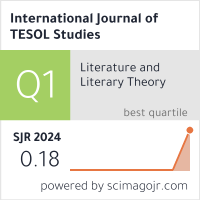2632-6779 (Print)
2633-6898 (Online)


Scopus
Ulrich’s Periodicals Directory (ProQuest)
MLA International Bibliography
MLA Directory of Periodicals
Directory of Open Access Journals (DOAJ)
QOAM (Quality Open Access Market)
British National Bibliography
WAC Clearinghouse Journal Listings
EBSCO Education
ICI Journals Master List
ERIH PLUS
CNKI Scholar
Gale-Cengage
WorldCat
Crossref
Baidu Scholar
British Library
J-Gate
ROAD
BASE
Publons
Google Scholar
Semantic Scholar
ORE Directory
TIRF
China National Center for Philosophy and Social Sciences Documentation
Kimberley Mouvet
Stamina, Bruges, Belgium
Miriam Taverniers
Ghent University, Belgium
Abstract
When training students at a tertiary level, we expect them to develop into expert users of language (Byrnes et al., 2006). This implies they are able to deal with linguistic problems of both a theoretical and a practical nature (Martin, 2016). However, what is often missing in our teaching practices is a model of language that would offer them the tools to do so (Hasan, 1999; Martin, 2016). Traditionally, proficiency programmes seem primarily concerned with grammatical rules and vocabulary expansion (Macken-Horarik et al., 2015). This focus on decontextualized language downplays the primary goal of language: to communicate with another (Halliday, 2014; Hasan, 1999). In our English proficiency programme we have adopted a systemic functional model of language to inform the design of our courses (Halliday, 2014). As such, we focus on lexicogrammar from an ideational point of view offering a metalanguage to talk about language (i.e. grammatics rather than grammar rules (Halliday, 2002)) and we add to this an interpersonal approach to the instances of language use in writing and speaking classes. Students are taught to operationalize these two (ideational and interpersonal) exploiting textual resources. Together, these three components — ideational, interpersonal and textual choices — construe the variables of context of situation: field, tenor and mode respectively (Martin, 2016). Working with these variables, we maintain, gives students a solid theoretical foundation and understanding of the functioning of language, and allows them to effectively communicate a focused purpose in any genre relevant to our culture.
Keywords
Tertiary education, English proficiency, systemic functional linguistics